-
Car Reviews
- Car News
-
Car Comparisons
Latest comparisons
- Chasing Deals
Despite its short range and hefty markup over the petrol version, this electric van could be a smart choice – and it can take some serious punishment
Imagine for a moment that you’re in charge of organising the rollout of fully electric versions of every vehicle on sale, and you’d need to do so in such a way that widespread take up would be encouraged. Which vehicle segment would you pick first?
Logically, it would have to be small city cars with low intensity requirements and infrequent usage. At the other end of the spectrum you have commercial vehicles like the Peugeot Partner, which work harder than just about anything else on the road.
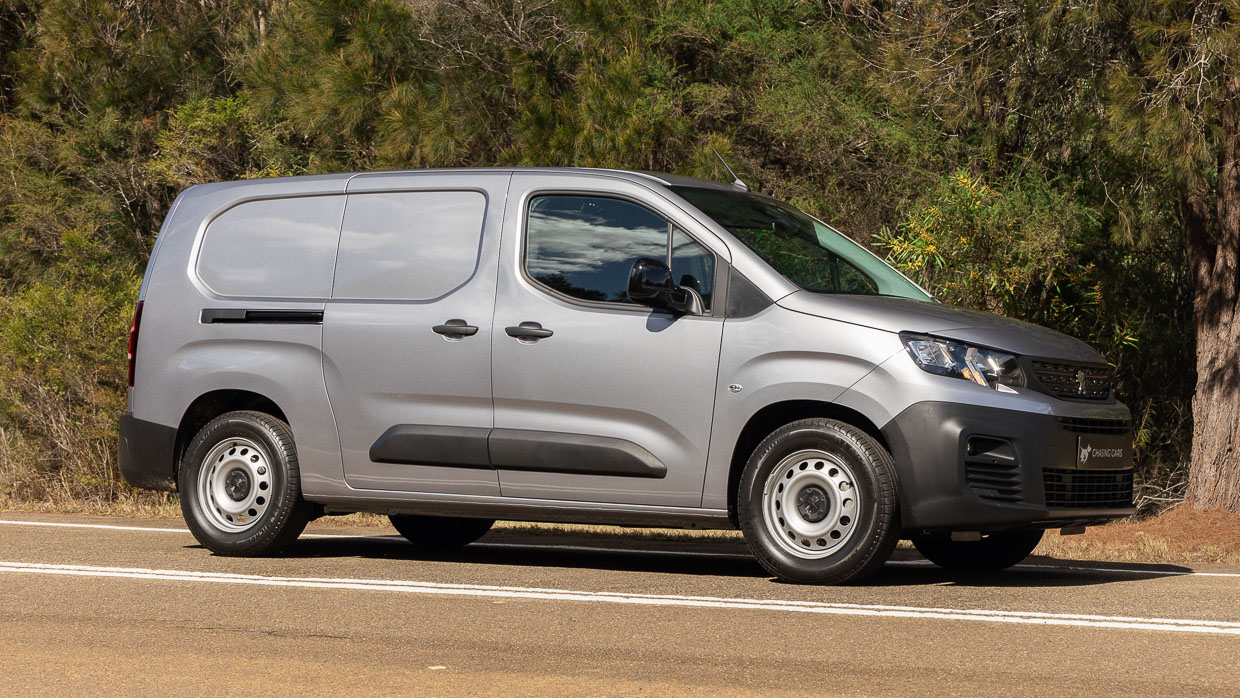
And yet EV vans have seen some of the most explosive growth in Australia of any vehicle segment on sale.
In the last few years, the Ford E-Transit, Mercedes-Benz EQV, Mercedes-Benz E-Vito, LDV E-Deliver 9 and now the fully electric version of the Partner, creatively badged the ‘E-Partner’, have appeared on the scene.
There’s more are coming too, including the E-Partner’s sworn rival in the Renault Kangoo E-Tech, set to go on sale in February 2024.
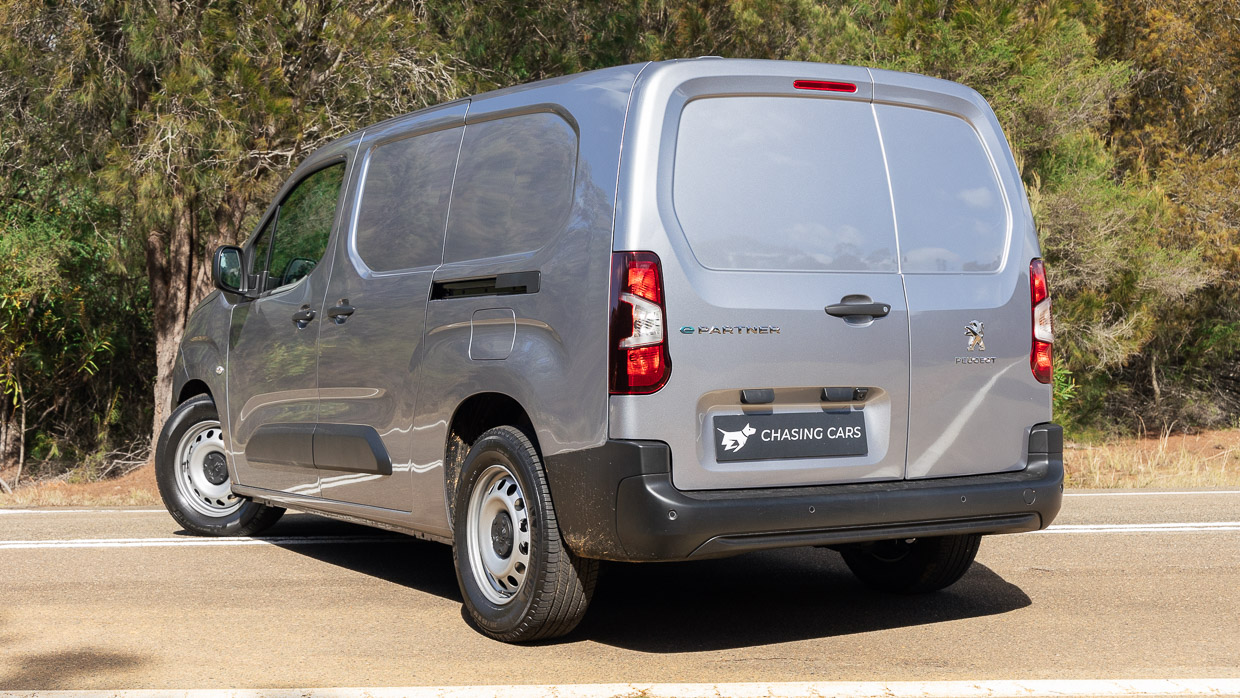
The E-Partner is the first of many EVs being introduced from the Peugeot brand to Australia with the E-208 hatch, E-308 hatch/wagon, E-3008 midsize SUV and the E-Expert midsize van all bound for our shores.
Peugeot wasn’t able to give us a full breakdown of the sales split of the petrol and electric Partner range, but in the last six months of 2023 after the E-Partner was introduced sales spiked by an impressive 46 per cent overall, so it’s clear some buyers are interested.
A driving force behind this appetite is a growing attitude from both government and private buyers, along with small businesses to lower their emissions. It’s often to reach internal targets, though the ‘green’ PR aspect can’t hurt either.
Organisations like these have cash to splash, and the decisions they make can have a real impact on the direction of the industry.
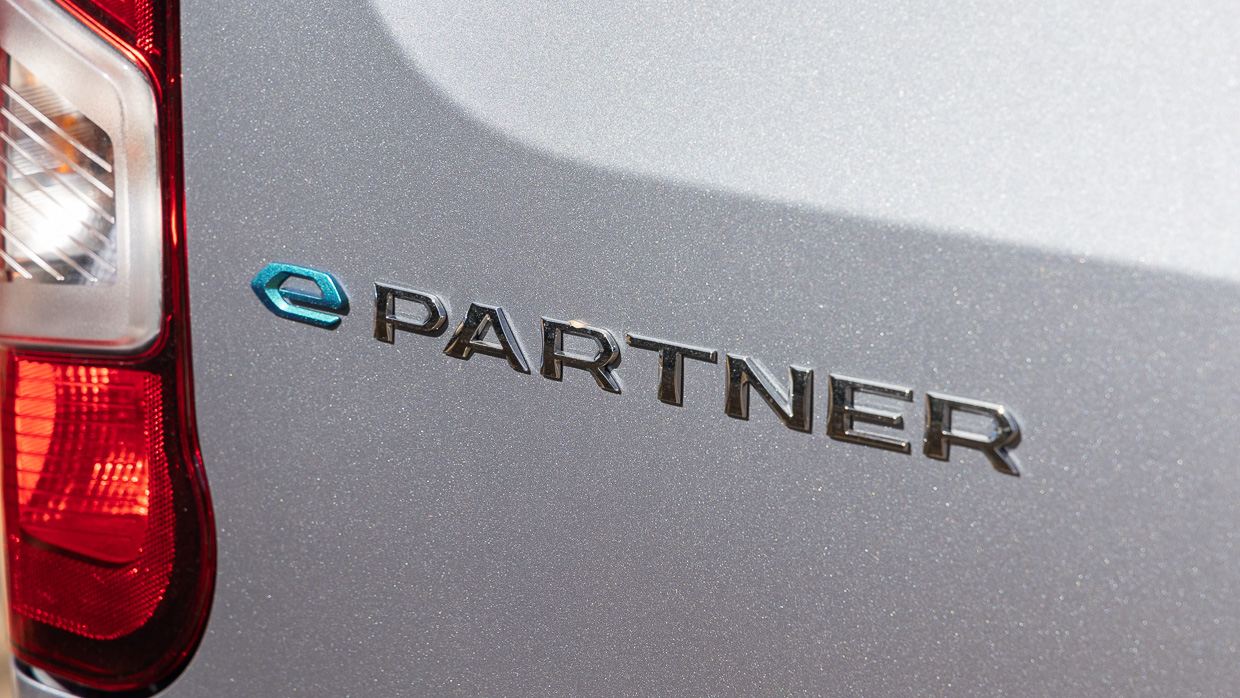
But they’ll need that sort of cash, as with a price starting at $59,990 before on-road costs, this E-Partner is $21,602 more expensive than its petrol equivalent and that’s a tall ask considering it only has 258km of range, according to the generally accurate WLTP testing protocols.
A hefty upfront cost is, however, less frightening if the on-going costs are cheaper than their traditional counterparts.
So does buying an EV van save money in the long run and, perhaps more importantly, can the all-electric E-Partner take the punishment expected of a commercial vehicle? We decided to find out.
The petrol-powered Peugeot Partner range starts at just $30,041 before on-road costs for the short-wheelbase (SWB) entry-level City grade. Above that, Peugeot offers the Pro and top-spec Premium grade in both SWB and LWB guise with prices topping out at $40,878.
The E-Partner is a one-size fits all situation, offered exclusively with the long-wheelbase chassis length and in the middling Pro grade for $59,990. Even though it is well-equipped for the task at hand, that list price is nearly enough to buy two of the petrol base models….
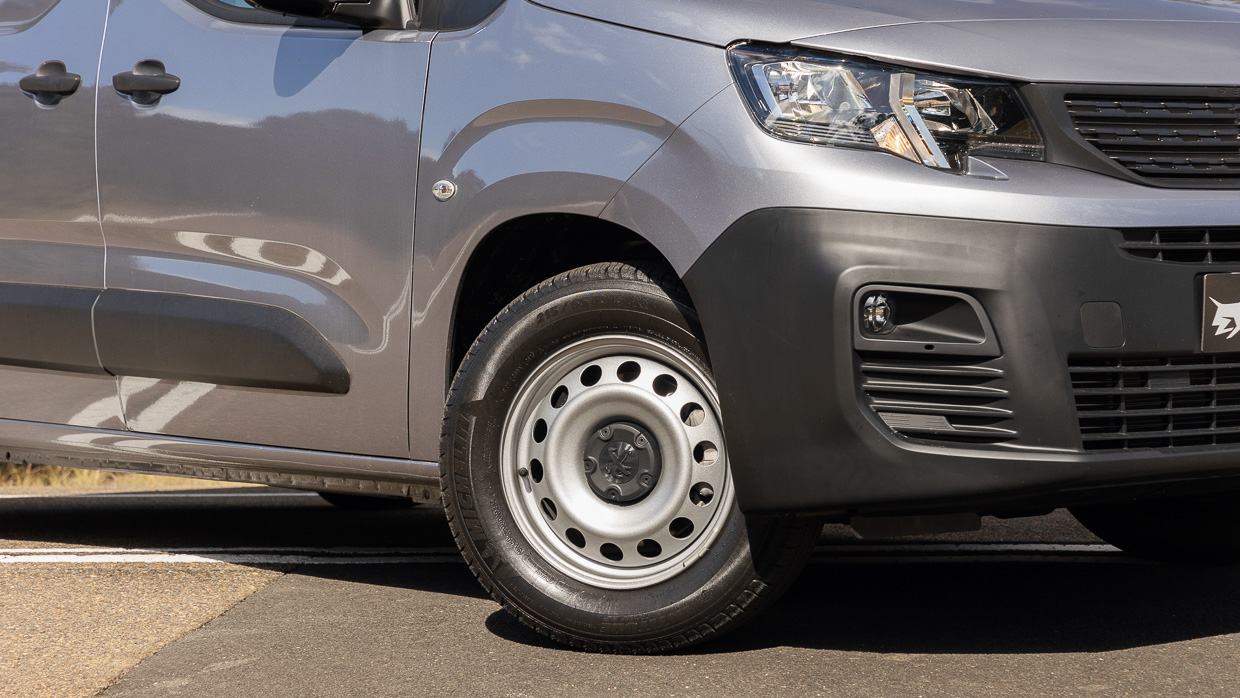
Some of the features included on the E-Partner Pro include:
As expanded upon further in this review, the EV version also misses out on the three-seat layout available in the petrol, which also features the ability to fold down as a workbench.
One of the electric Peugeot’s key advantages over its petrol or diesel counterparts reveals itself as soon as you hop in and put it into gear: the almost complete absence of noise.
In the name of cost savings, vans often have little in the way of sound deadening, meaning the full brunt of their rough and tumble engines are passed through to the cabin.
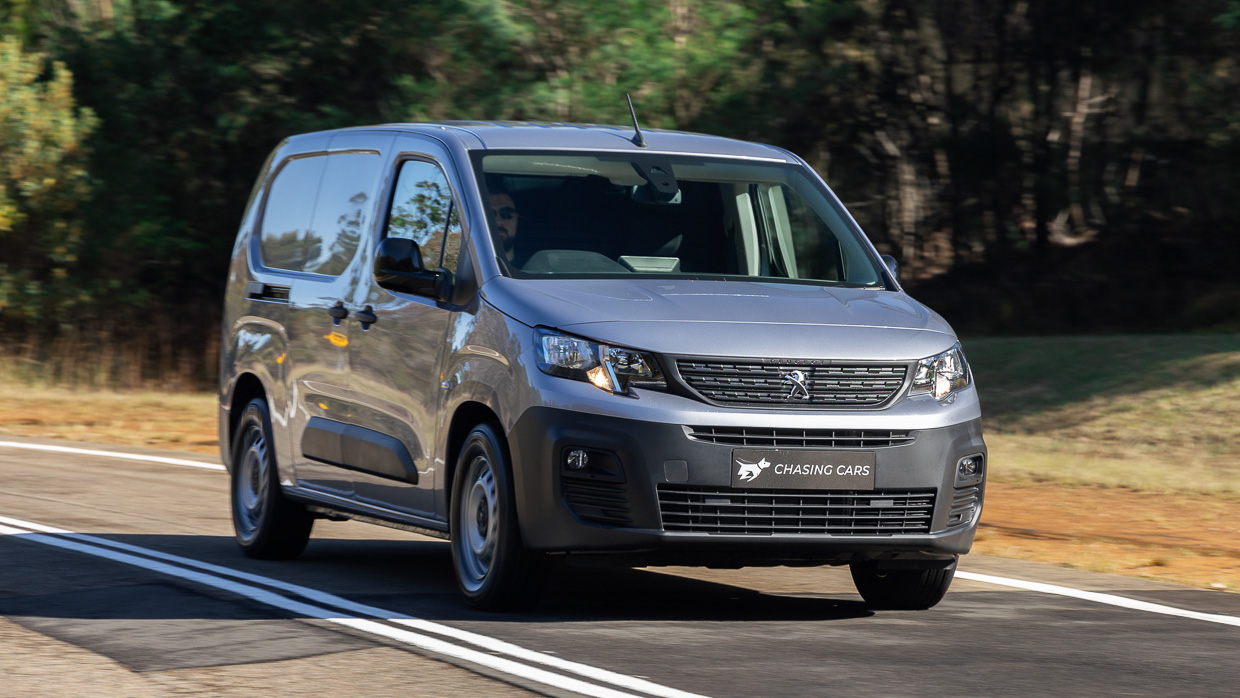
Scoff all you like at the snow-flakery of the idea, but study after study has shown that sustained exposure to noise, vibration and harshness (NVH) can have a serious impact on your health, stress levels and also your ability to concentrate.
Ever turned down the radio when trying to find a park? The impact is similar.
Setting off from stationary, the E-Partner possesses similar qualities to a turbo-diesel with its torque down low, which is ideal for stop-start city traffic.
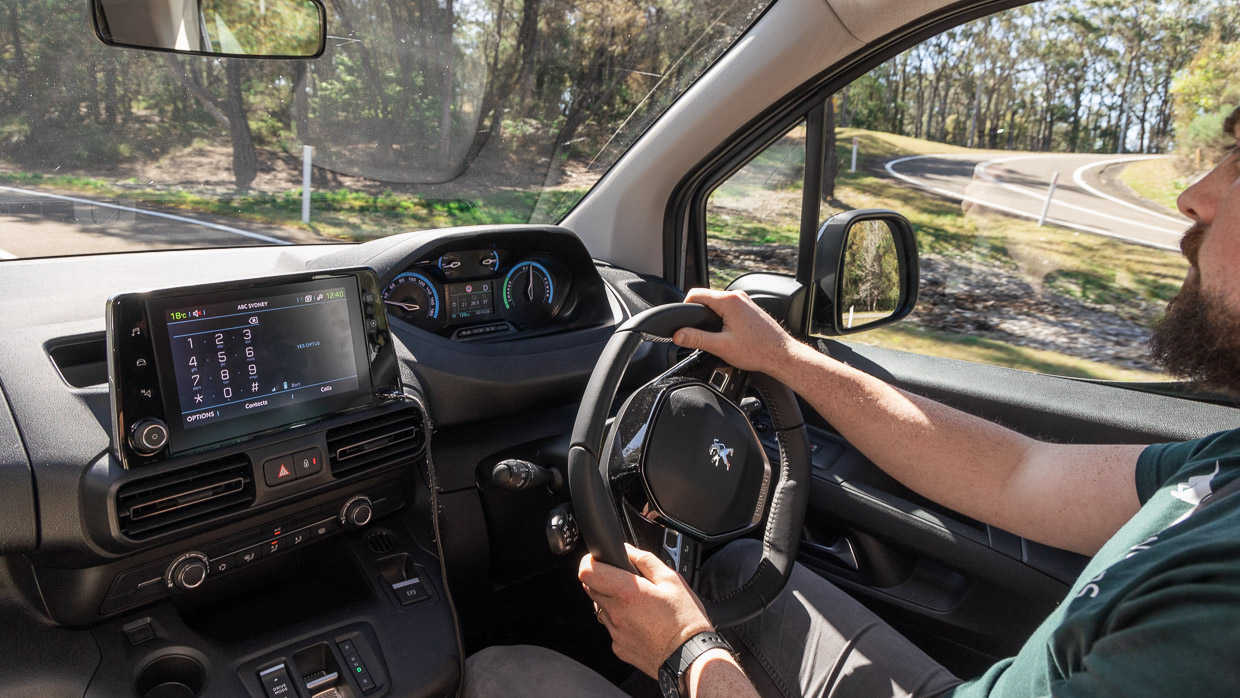
Peugeot has wisely taken some of the bite out of the initial acceleration, so the apprentice won’t be taking the skin off the tyre every time they enthusiastically take off from the lights.
The 100kW/260Nm motor sits on the front axle and is plenty powerful enough but this figure is only available in the ‘power’ mode. The default ‘normal’ and ‘eco’ drive modes are limited to 80kW/210Nm and 60kW/190Nm respectively.
As you might imagine, eco mode is designed to provide the maximum amount of driving range for the E-Partner, though I did find the restriction to 60kW was a step too far in aggressive traffic conditions. On the highway, though, this matters less.
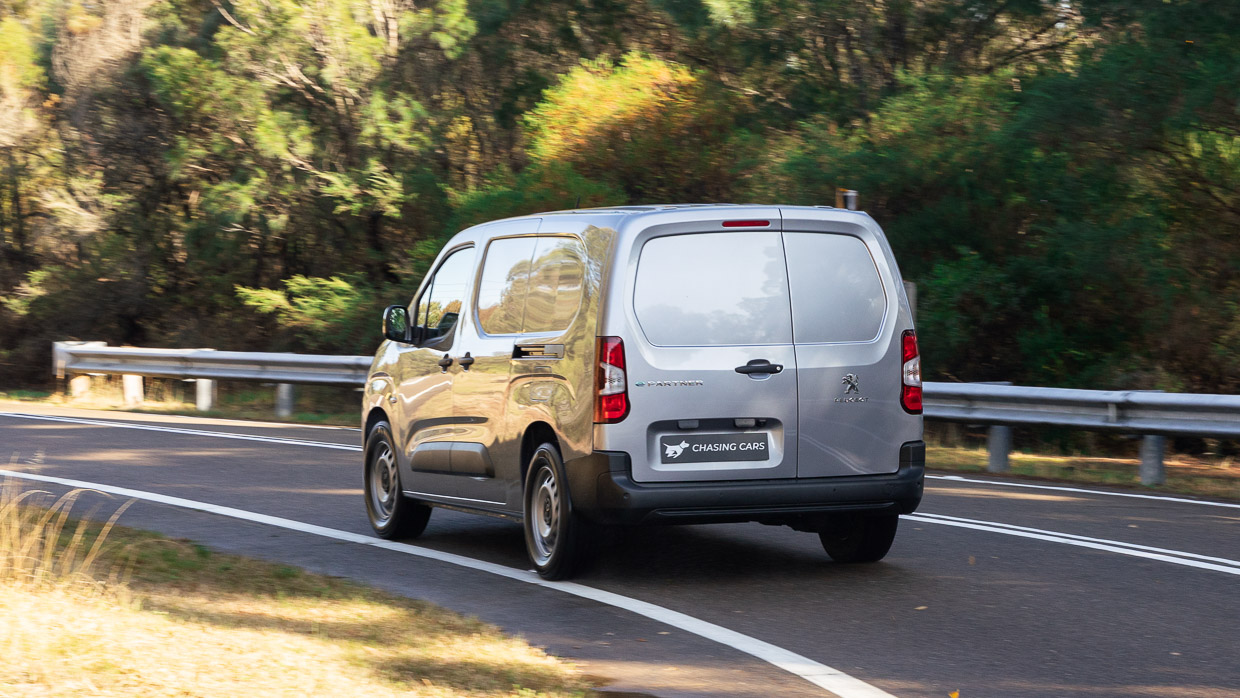
Speaking of which, unlike the LDV E-Deliver 9 for example (which is capped at 90km), the E-Partner is more than capable of travelling at Australia highway speeds as it offers a top speed of 135km.
The Peugeot is more likely to be spending much of its time at slower speeds though, so how does it drive?
The small steering wheel design of Peugeots isn’t loved by everyone in the Chasing Cars office, though I and some others certainly do like it. Personally, I think the one-handed usability plays well with this city-focused van and aids in providing the relatively tight 11.4m turning circle.
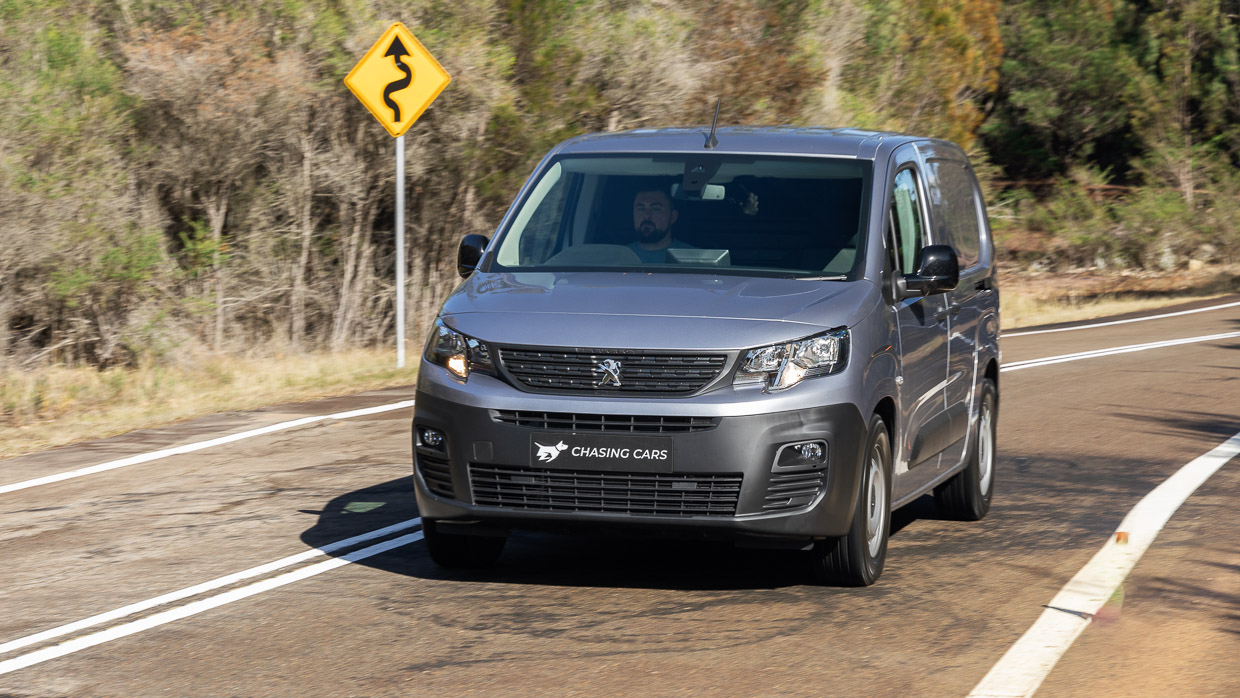
Despite its load carrying capacity, the E-Partner retains near car-like agility in town and the renowned EMP-2 platform it sits on means it drives pretty well too, especially considering its commercial focus.
At 1632kg, the E-Partner is remarkably lightweight. It’s just 247kg more than the equivalent petrol model. Like you would expect in a commercial van, the ride is a bit choppy and undisciplined when unladen but not terribly so.
So how does it drive when actually weighed down? Well to find that out we had an appointment with a half-tonne steel plate.
The additional weight of the 46.3kWh lithium-ion battery has impacted the overall payload of the E-Partner, which drops from 864kg in LWB models to 753kg in the electric model. The GVM is also bumped up by 65kgs to 2385kg.
The towing capacity has also taken a hit, dropping from 950kg to 750kg – but credit to Peugeot for even including a rating when others like Ford have left the E-Transit van entirely unrated.
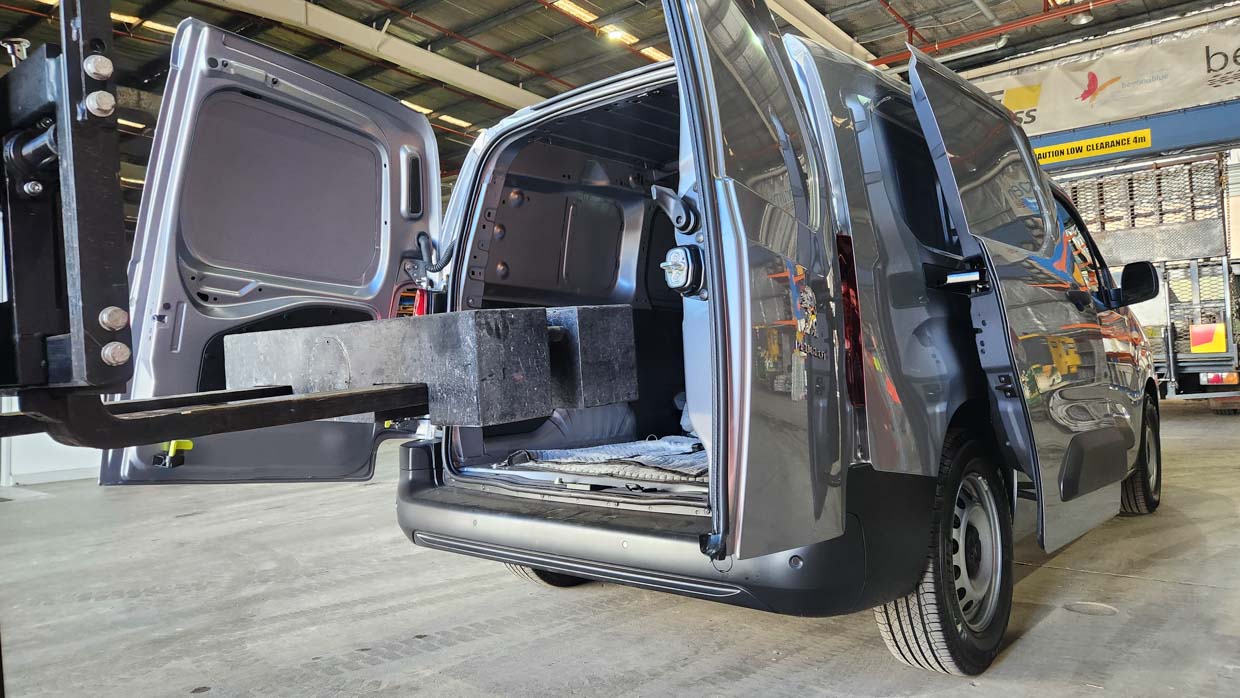
Small vans such as these are rarely focussed on outright carrying capacity but for the sake of science we wanted to weigh the Partner down considerably and opted for a 500kg steel plate to be lowered into the back. Add the weight of the driver and other equipment onboard and you have a total payload of around 600kg.
The weight itself was positioned low on the floor and strapped down. For the record, a regular Euro-size pallet does fit in the rear of the E-Partner – but only just – and I wasn’t game to challenge the skills of a forklift driver I’d only just met, with a vehicle I didn’t own. So the steel plate went straight in.
We conducted a 21km driving loop back-to-back to see how the E-Partner would behave loaded and unloaded. The urban route, based in western Sydney, saw us travel up to 70km/h, through some tight back streets and up a very steep hill.
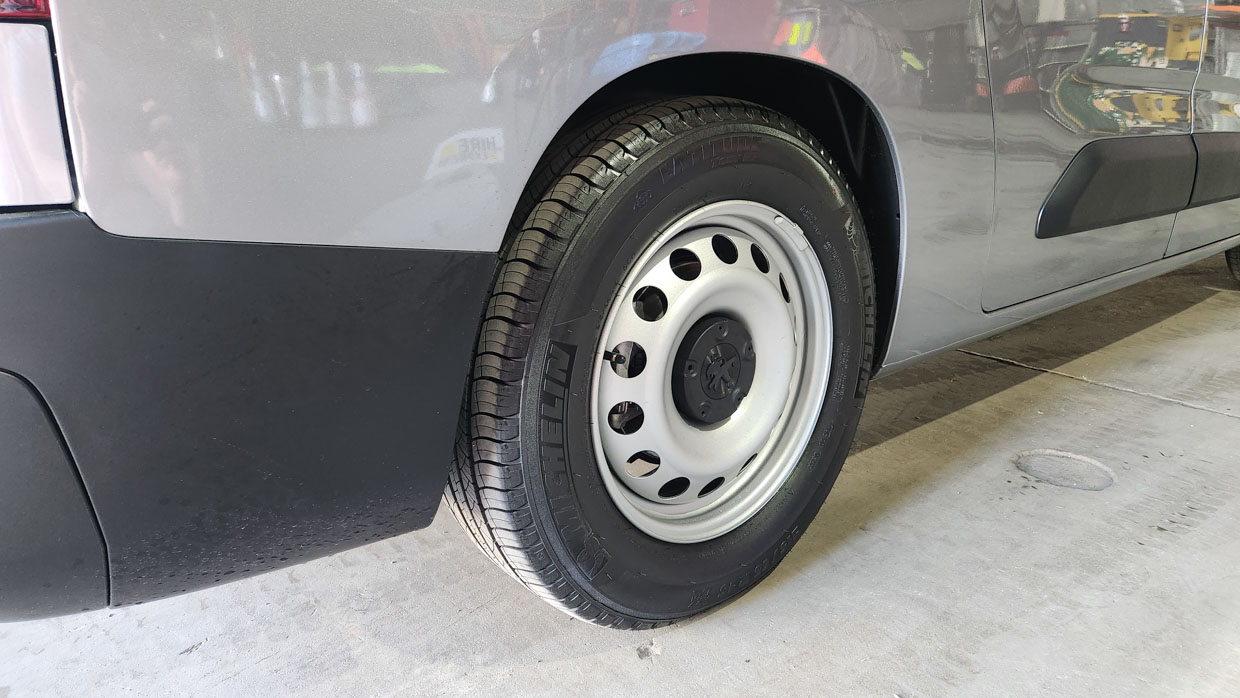
The effect of the weight in the Peugeot’s cabin is immediate with some droop observed on the rear axle but hardly enough for it to be riding on the bump stops.
In motion, the ride was more settled with the additional load on board; you are more susceptible to a rogue speed bump but nothing too uncomfortable.
Left in ‘normal’ mode, the electric motor pulls strongly and without fuss. I only briefly reached for the ‘power’ mode when overtaking a long truck. Eco mode, predictably, was entirely useless in traffic.
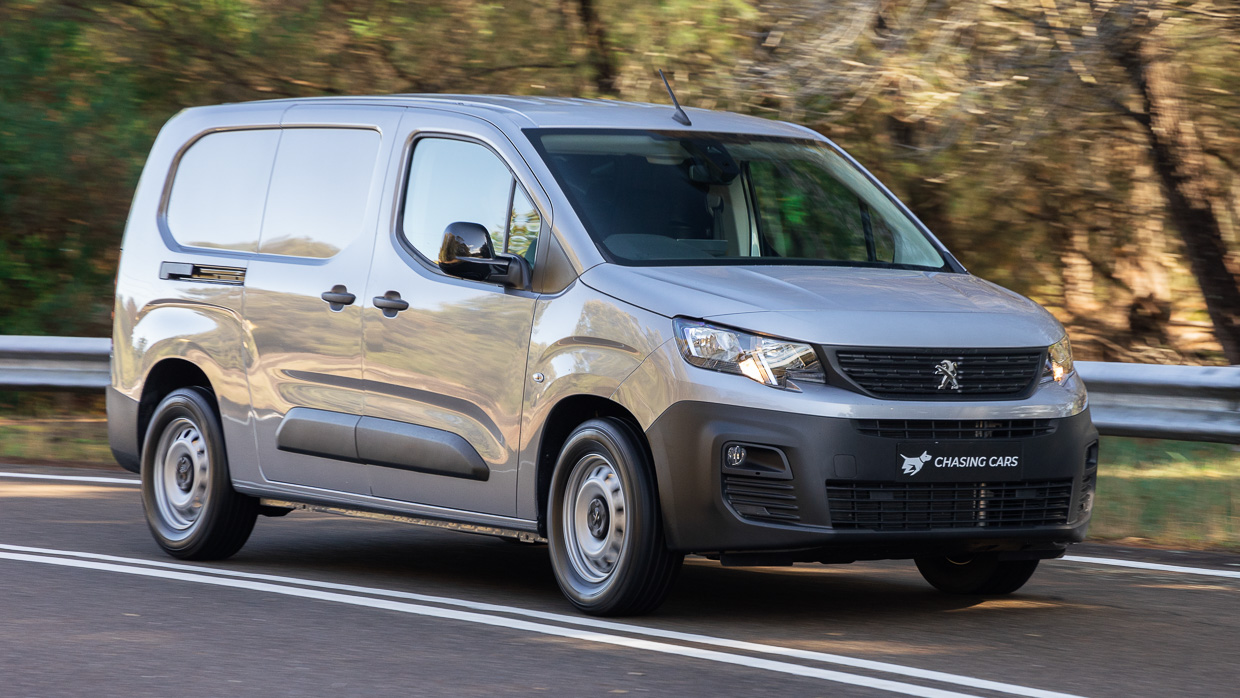
Despite the increase in both vehicle weight and GVM, the E-Partner retains the same disc brake setup as the petrol model, but I didn’t find this to be a concern as the brakes felt strong in practice.
And in practice, there isn’t really a great need to use them all that much either, drivers can simply lean on the regenerative braking function for most of their braking, including the ‘B’ mode by the shifter which makes the regeneration much stronger. Sadly though, there is no true one-pedal driving mode.
The efficiency of this test is discussed in the running costs segment of this review.
The interior of the E-Partner is delightfully car-like in its design though the materials and choice sections of design make it a place designed to last. What do I mean by this? I’ll explain.
Hard, scratchy and shiny plastics layer the interior but they’re also likely to last the test of time. Adding a touch of niceness however is the leather steering wheel complete with satisfying buttons and switches, which connects to the modern 8.0-inch multimedia display.
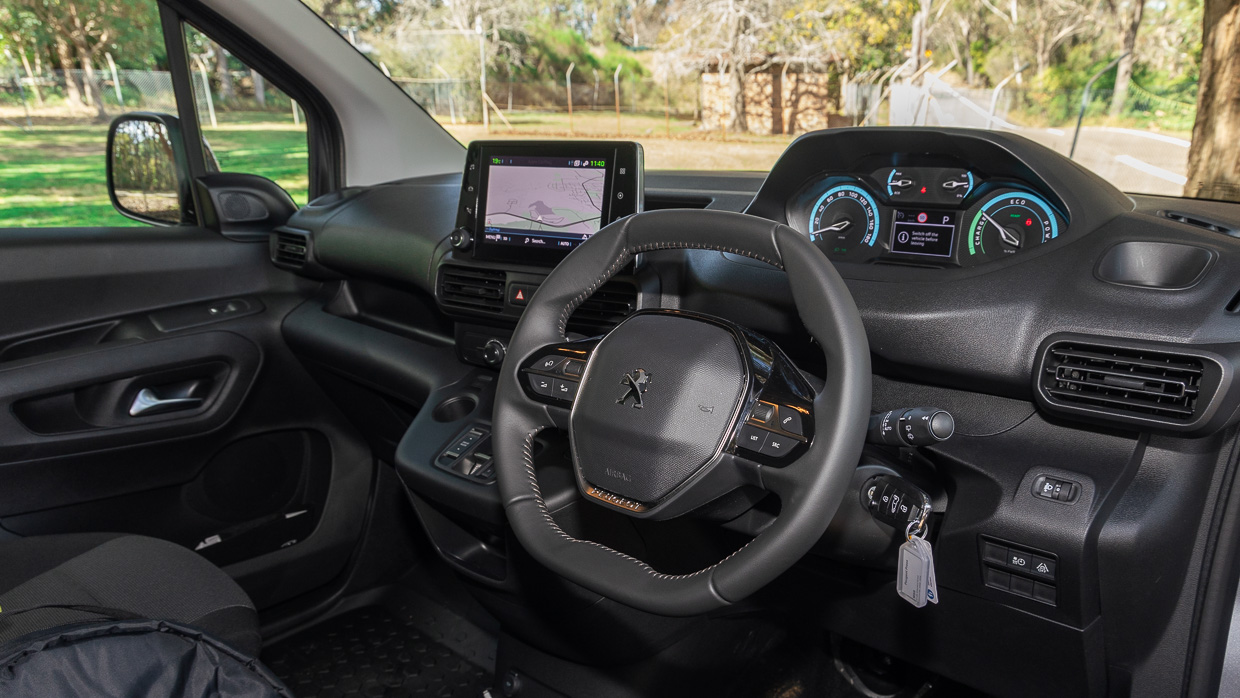
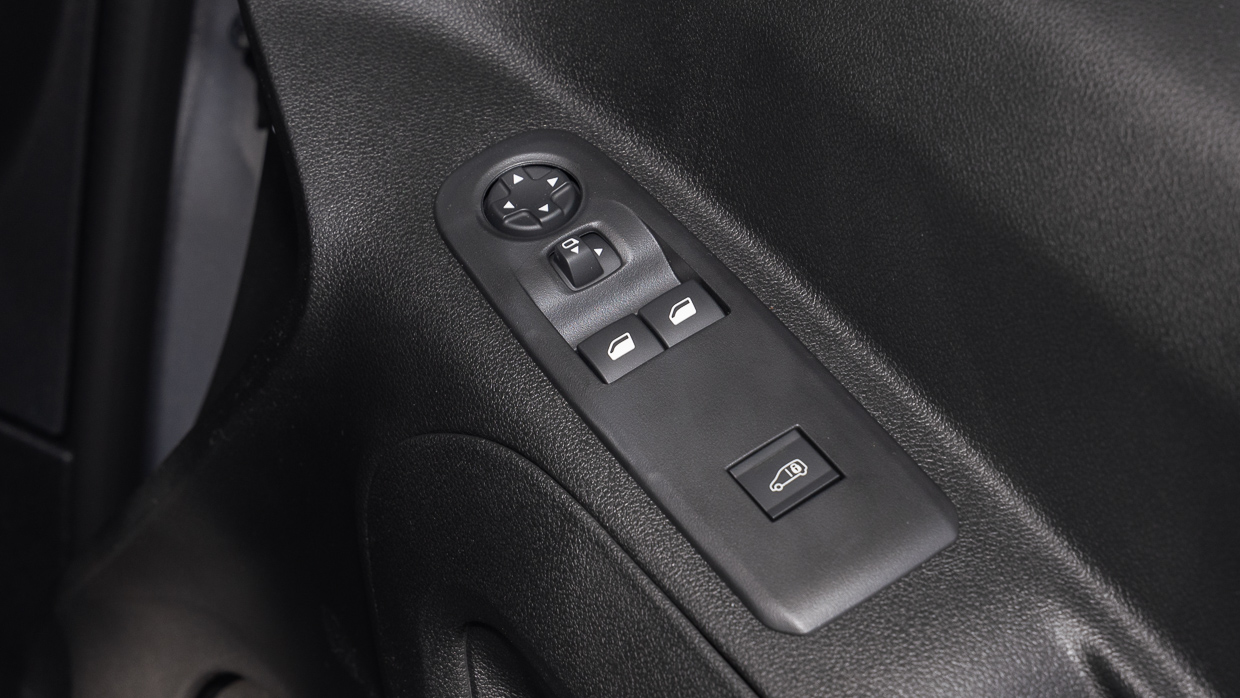
This display comes with the sort of contemporary conveniences that we’ve come to expect such as satellite navigation along with wired Apple CarPlay and Android Auto.
Music is fed through a four-speaker stereo system, which is nothing special, but the net effect of all is that the cabin retains just enough comfort to make the cabin of the E-Partner a place you can easily do a few hours in every day.
Adding to this is the set of cloth-covered seats which provide good back support. A fold-down armrest is provided for the driver but not the passenger.
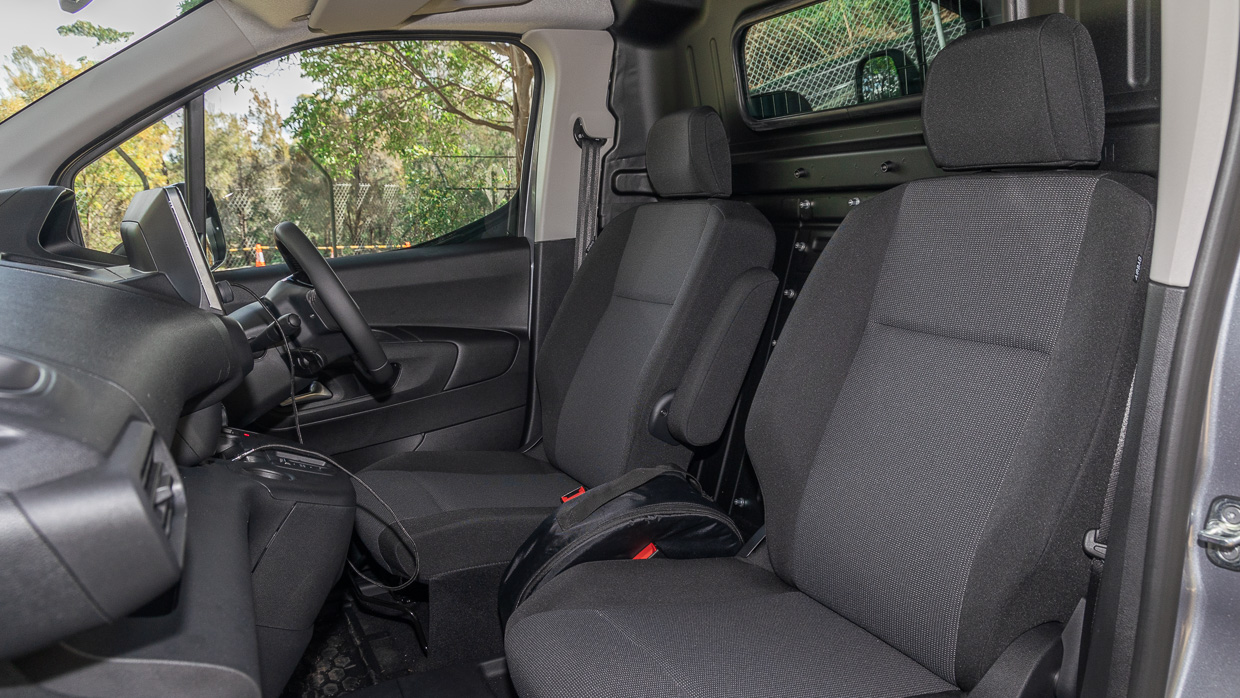
Peugeot couldn’t give us an answer as to why (though it’s likely to save weight), but the E-Partner sadly forgoes the three-seat setup provided in the petrol model. This middle seat isn’t just useful for extra carrying capacity but also because it folds down into a smart little work bench.
Instead, there is a gaping hole between the seats with no clear purpose; though I used it to hap-hazzardly stow the charging cable as there is no clear place to keep that in the front or back of the cabin.
Given the huge power source on board, it struck me as a real missed opportunity that the fold-down bench wasn’t retained. Bundle this with an in-cabin three-pin socket and you suddenly have a mobile office with a steady power supply and air-conditioning when out on the road – but alas it was not to be.
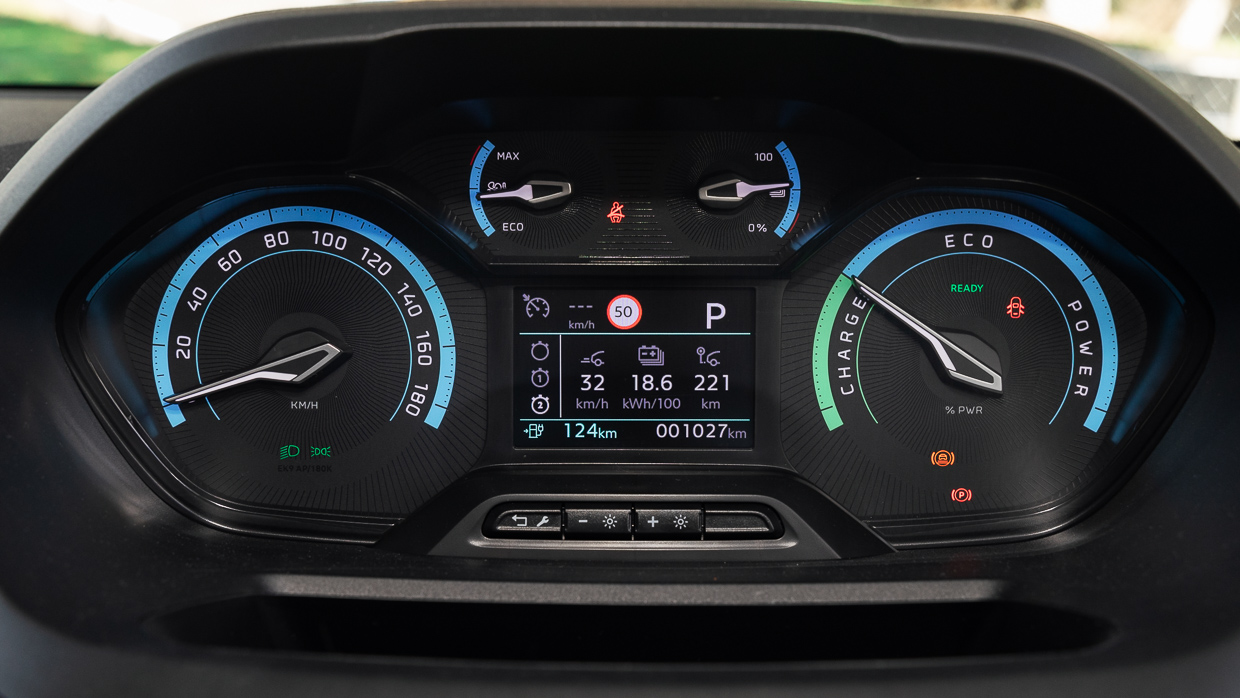
The E-Partner sports a gauge cluster unique to this variant, teamed with small digital read out so you can monitor your energy consumption or predicted range on the road.
It won’t come as a great surprise to van drivers that the rear-view mirror of the E-Partner is useless, as is often the case in vans, but due to the reflective nature of the cabin window cut out this one is especially bad.
Hilariously, the only thing that can be seen in the rear-view mirror is the centre touchscreen so it’s best to learn how to work those small side mirrors quickly.
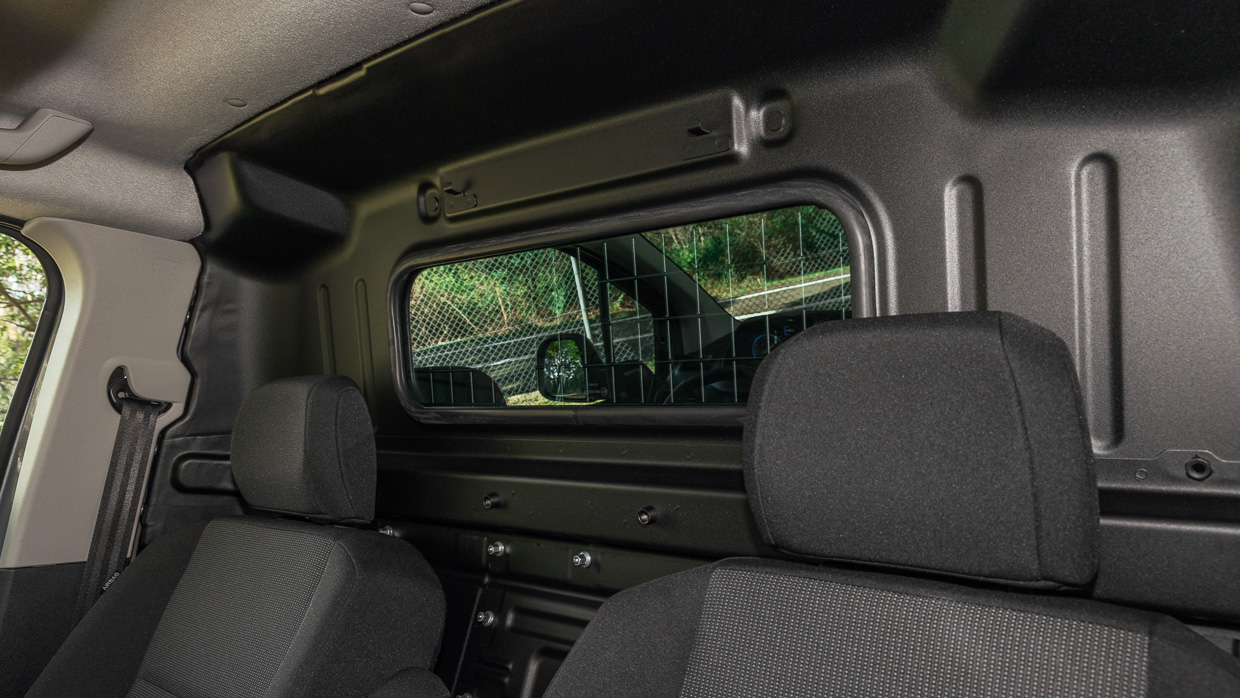
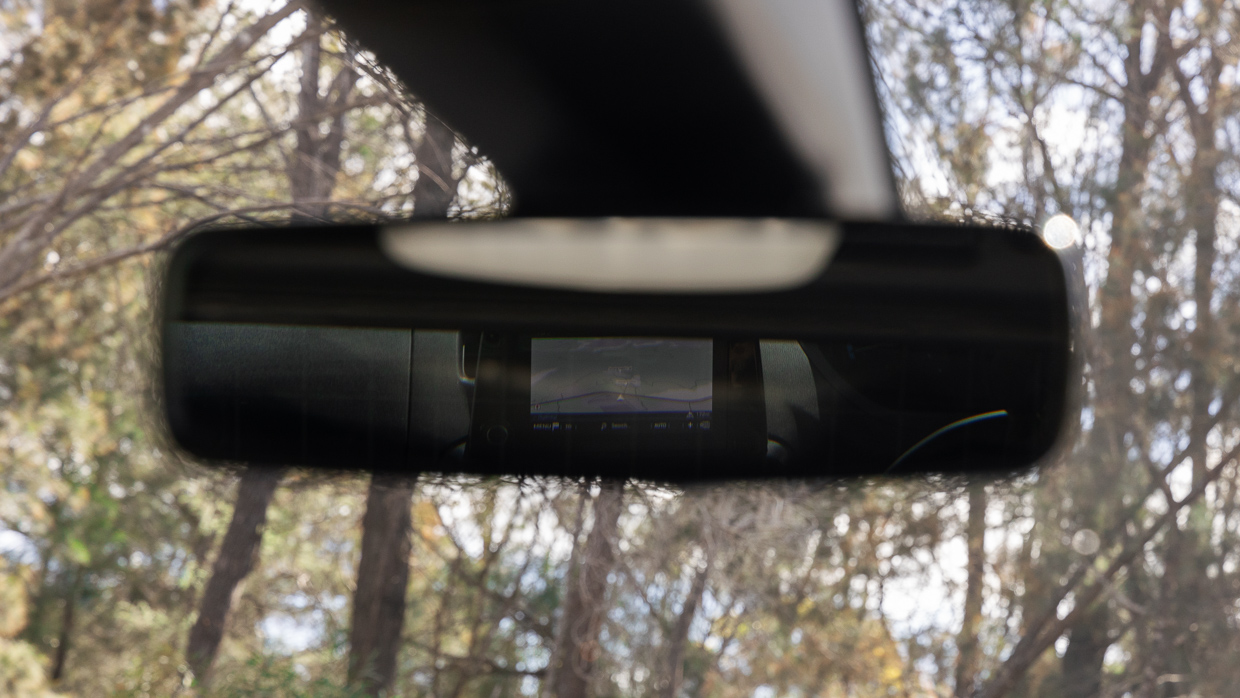
The E-Partner misses out on some niceties available on the top-spec petrol such as dual-zone climate control, push button start and the odd 12-volt socket but there’s nothing lost of high consequence. Still, with that price premium it would be nice to have it all.
In the back of the van, Peugeot proudly proclaims there is zero compromise to the 3.9 cubic metres of space, which is impressive given the size of the battery pack and the fact that the E-Partner hasn’t lost its full-size spare in the process.
For reference, the Kangoo E-Tech has a slightly larger capacity of 4.2 cubic metres in long-wheelbase guise, though it beats out the Volkswagen Caddy which maxes out at 3.7 and does not feature an electric option.
Other key measurements of the E-Partner include the following:
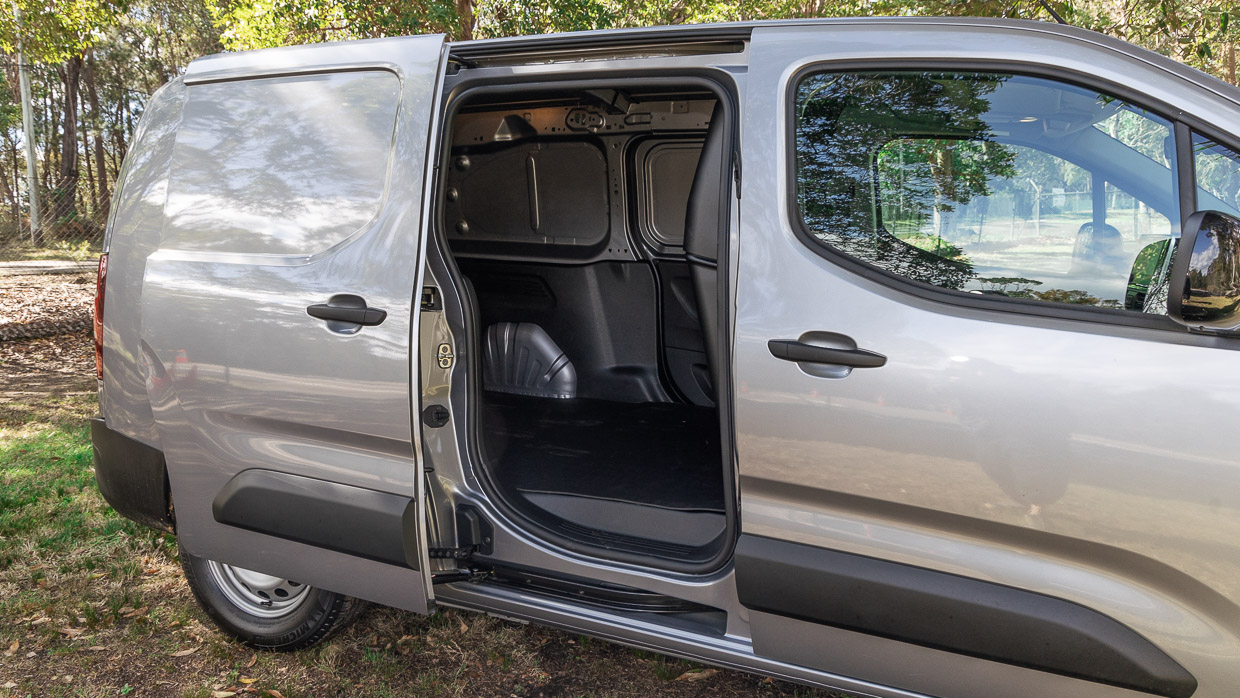
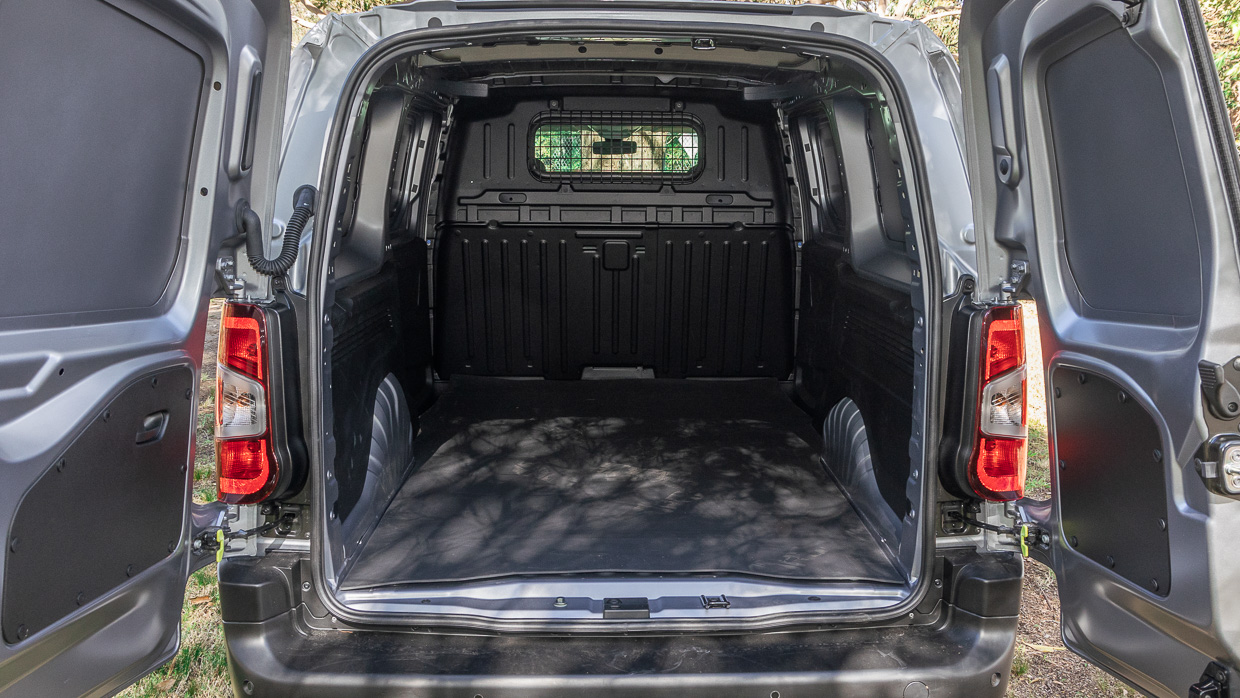
Bizarrely, Peugeot only fits the electric variant of the Partner with six tie-down points when the petrol comes with 10; and the absence of a three-pin socket in the rear is a shame for tradies who might be looking to fire up or charge the odd powertool when out on site.
Still, the standard fitment of dual-sliding doors and rear barn doors which can be unhooked and left open while loading should make life a bit easier.
The Peugeot Partner range is covered by a five-star ANCAP rating, which was awarded to the van back in 2018 – but this rating only extends to the petrol and diesel models.
Some of the safety features included on this model include:
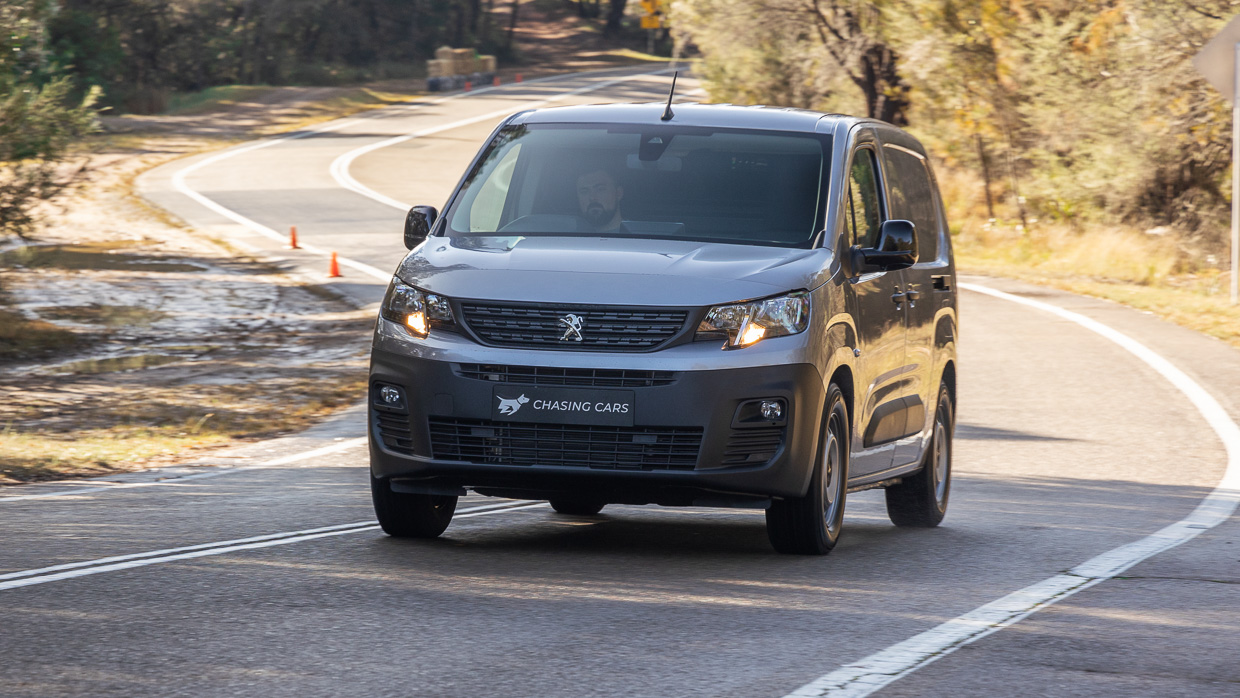
In practice, these safety features perform quite well though I will note that a bad combination of small side mirrors, the lack of blind-spot monitoring and the natural tendency of windowless vans to have poor side visibility made for some very tricky merging onto a busy highway during our test drive.
Also notable is the fact that the E-Partner, being a silent-running EV, comes fitted with an automatic sound generator so you won’t catch those in the workshop or those pesky pedestrians by surprise.
The E-Partner is fitted with a 46.3kWh usable battery (50kWh gross) with a WLTP range of 258km, translating to an expected efficiency of around 17.95kWh/100km.
Chasing Cars saw an average of 17kWh during our testing, which included a mixture of driving conditions and time carrying heavy loads during the aforementioned GVM test.
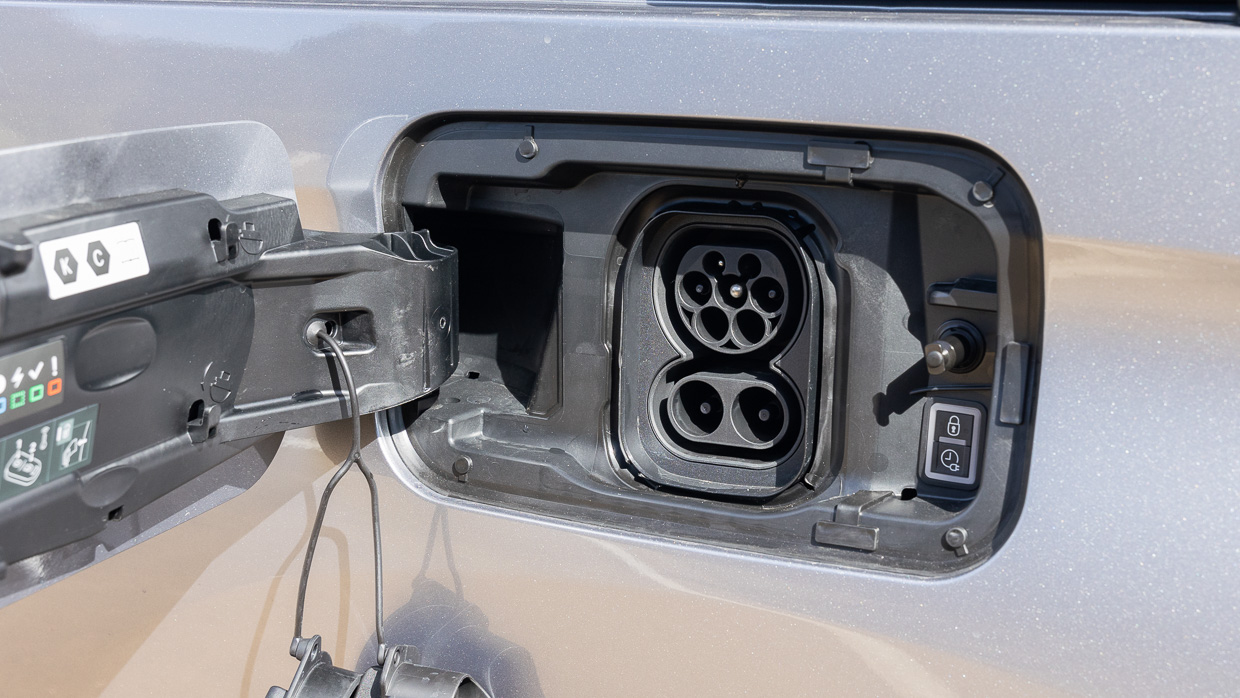
During that test the unladen efficiency was 13.9kWh/100km, while laden it was 18kWh/100km. This means that even with 500kg in the back, the driving range is still likely to be within reach of the original WLTP claim.
Once the battery is flat, buyers can plug into a home-style 7.4kW AC wallbox and recharge from flat to full in seven and a half hours.
Alternatively, the driver – perhaps during their lunch break – can plug into a 100kW DC fast charger and see the battery topped up from zero to 80 percent in around 30 minutes, says Peugeot.
Not everyone is fortunate enough to be able to charge their electric vehicle with a solar setup to negate the additional electricity consumption of an EV, so here is a short breakdown showing how much it could cost to charge and how it compares with the petrol model when driving over 100km.
For the sake of simplicity, we’ll ignore the relatively minimal charging losses and be using our as-tested consumption of 17kWh/100km and comparing it against the LWB petrol model’s official claim of 5.9L/100km.
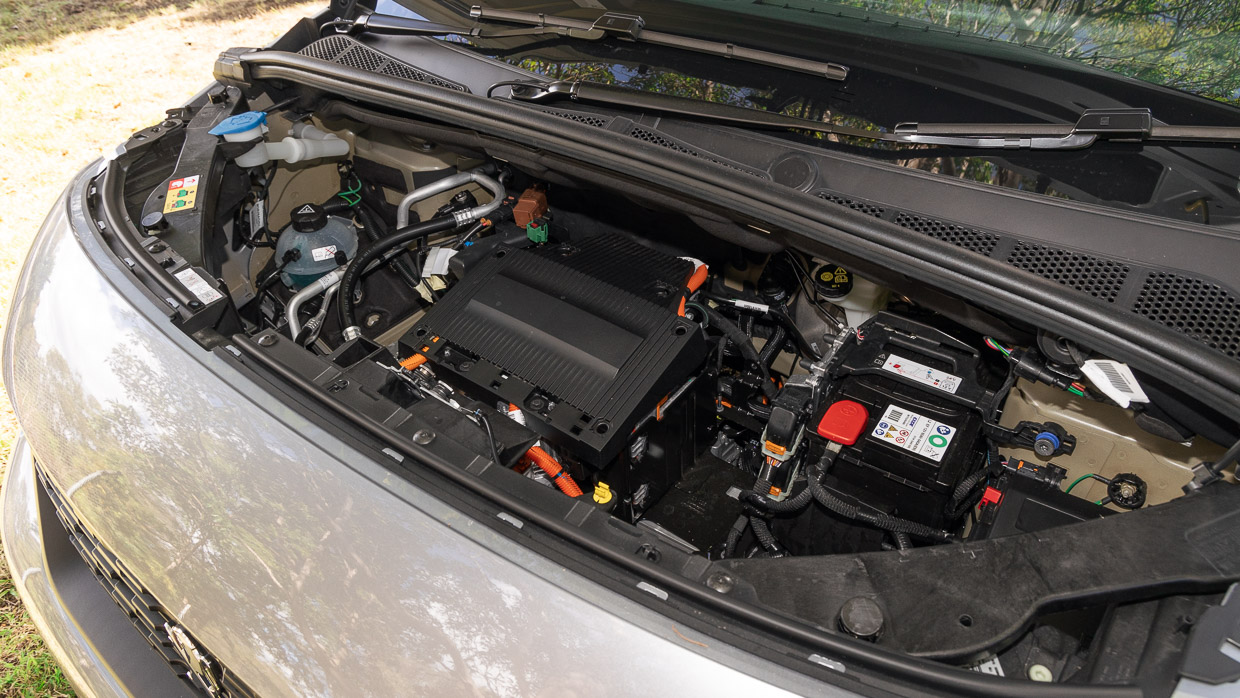
The servicing intervals are every 12 months or 25,000km and will cost $1000 over five years. Worth noting is the fact that the distance intervals are twice as long as the petrol version and will cost you half as much to service over that five-year period.
The E-Partner is offered with a five-year, unlimited 200,000km vehicle warranty with a separate eight-year, 160,000km warranty applied to the EV drivetrain. This applies to both private and commercial buyers.
In 2024, businesses both large and small will be asking themselves if electric vehicles are worthy of consideration for commercial purposes and the answer will be different depending on user requirements.
The E-Partner has a short stated range of 258km but it’s one the French van is at least capable of achieving, both laden and unladen, in our experience.
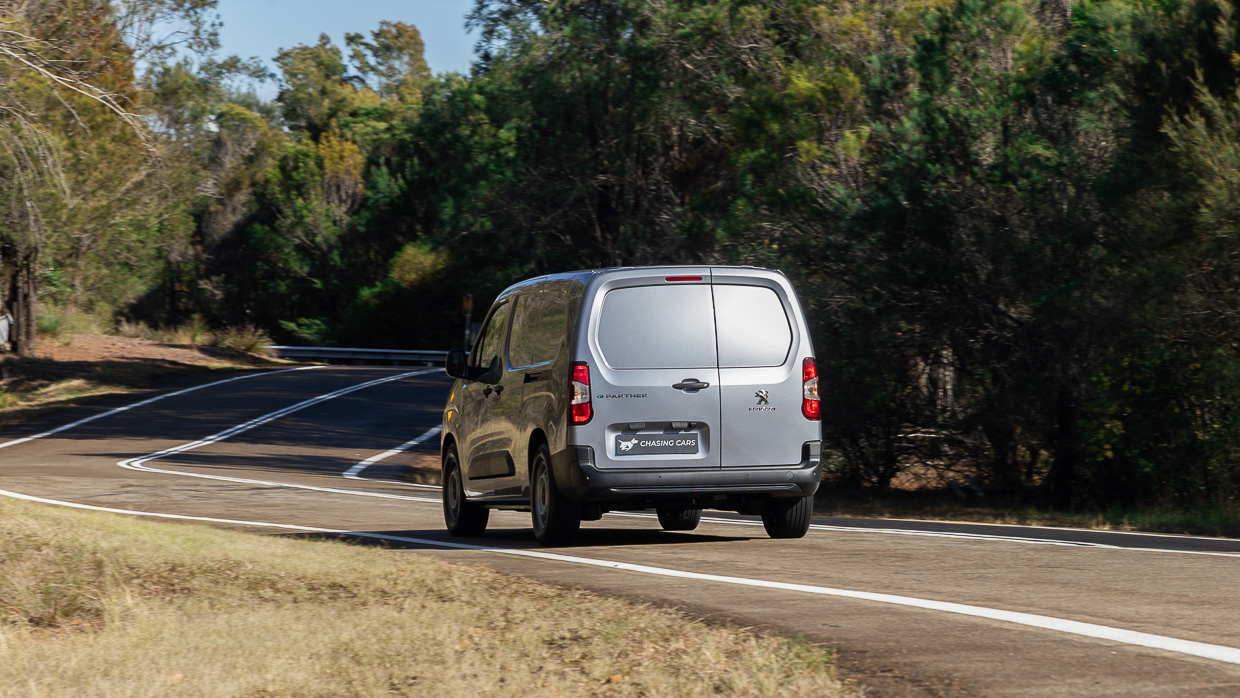
Previously when I reviewed the E-Transit, Ford made note of the fact that its buyers only drove an average of 115km per day so perhaps this range is enough for most city-based buyers.
With its $59,990 price tag (before on-road costs) the E-Partner is a significant $21K jump over its petrol counterpart and this premium does need to come down if we are to see widespread adoption. However, the Peugeot does offer some recompense in the form of cheaper running costs with broadly the same capability.
The real test for the E-Partner will come with the arrival of the new-generation Kangoo E-Tech which boasts greater interior storage and slightly more driving range with a similar price tag.
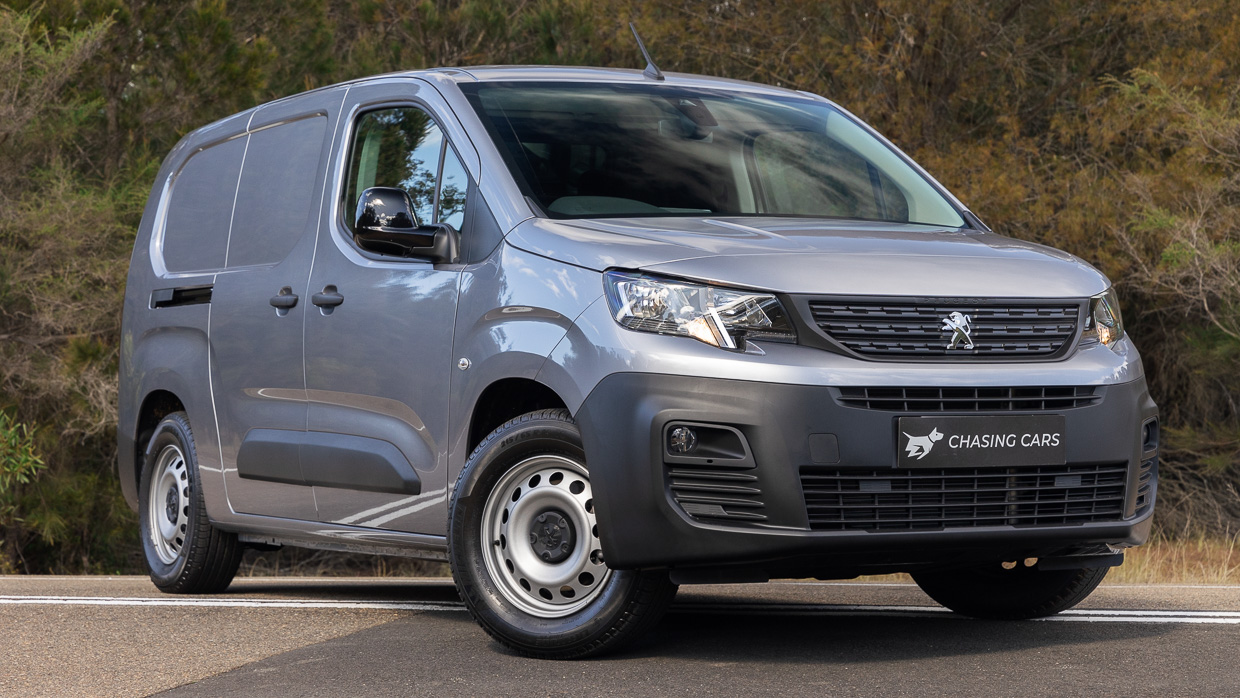
Those looking for something a bit larger can also consider the just-released LDV eDeliver 7 which has more range and more space at the same price as the Peugeot; though like its sibling it’s limited to 90km/h.
Regardless of which option buyers go for, all options are markedly more affordable than existing EV commercial vehicles like the LDV E-Deliver 9 and Ford E-Transit, which retail for around $100,000….
A sub-$60K price tag is certainly an easier pill to swallow if buyers are looking to convert their fleet to vehicles which aren’t just kinder to the environment, but perhaps their drivers too.
About Chasing cars
Chasing Cars reviews are 100% independent.
Because we are powered by Budget Direct Insurance, we don’t receive advertising or sales revenue from car manufacturers.
We’re truly independent – giving you Australia’s best car reviews.
The estimate provided does not take into account your personal circumstances but is intended to give a general indication of the cost of insurance, in order to obtain a complete quote, please visit www.budgetdirect.com.au. Estimate includes 15%^ online discount.
^Conditions Apply
Budget Direct Insurance arranged by Auto & General Services Pty Ltd ACN 003 617 909(AGS) AFSL 241 411, for and on behalf of the insurer, Auto & General Insurance Company Limited(ABN 42 111 586 353, AFSL 285 571).Because we don’t know your financial needs, we can’t advise you if this insurance will suit you. You should consider your needs and the Product Disclosure Statement before making a decision to buy insurance. Terms and conditions apply.
Indicative quote based on assumptions including postcode , 40 year old male with no offences, licence suspensions or claims in the last 5 years, a NCD Rating 1 and no younger drivers listed. White car, driven up to 10,000kms a year, unfinanced, with no modifications, factory options and/or non-standard accessories, private use only and garaged at night.
^Online Discounts Terms & Conditions
1. Discounts apply to the premium paid for a new Budget Direct Gold Comprehensive Car Insurance, Third Party Property Only or Third Party Property, Fire & Theft Insurance policy initiated online on or after 29 March 2017. Discounts do not apply to optional Roadside Assistance.
2. Discounts do not apply to any renewal offer of insurance.
3. Discounts only apply to the insurance portion of the premium. Discounts are applied before government charges, taxes, levies and fees, including instalment processing fees (as applicable). The full extent of discounts may therefore be impacted.
4. We reserve the right to change the offer without notice.